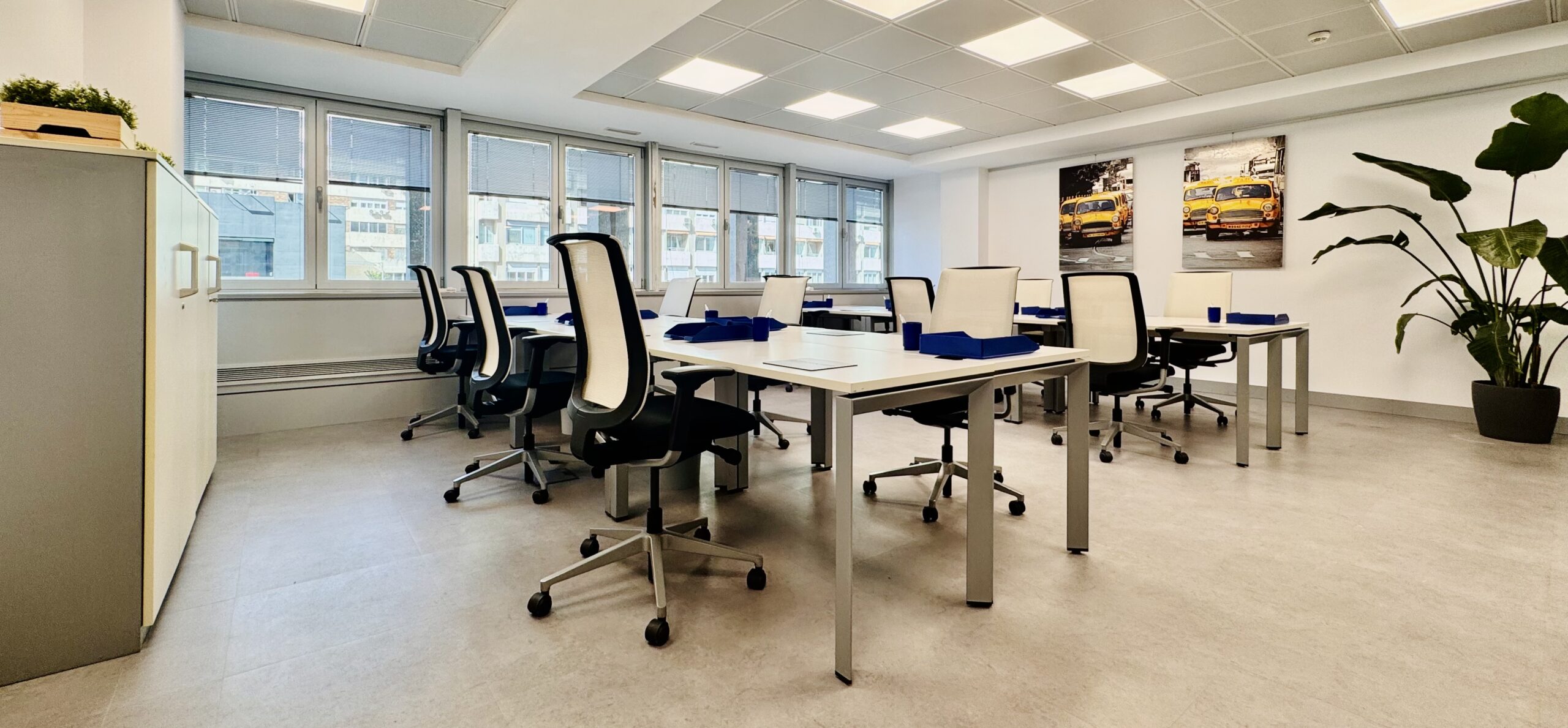In the age of digitalisation and the rise of teleworking, the physical workspace continues to play a significant role in the business fabric. An office is not simply a place to carry out work activities; it is a reflection of a company’s identity, a meeting point for the team and, on many occasions, the first impression that a potential client or partner has of an organisation.
But how much does it really cost to rent a traditional office these days? The cost of renting a traditional office goes beyond a simple monetary figure; it involves aspects such as location, size, facilities and many other factors that, together, determine the real value of a space.
In this article, we will break down the various components that influence the cost of renting a traditional office, providing a comprehensive guide for those looking to establish or relocate their operational base.

The importance of having a physical space
In an increasingly digitised world, it may seem that physical space has become less relevant to businesses, but a tangible presence in the real world is still essential for several reasons:
- Credibility and professionalism: Having a physical location gives customers and employees a sense of stability and trust. It represents a long-term commitment and provides reassurance that the company has a stable base.
- Collaborative space: While digital tools facilitate communication, face-to-face teamwork can be more efficient and effective. Face-to-face interactions facilitate understanding, avoid misunderstandings and foster creativity.
- Separation between work and personal life: Especially for small businesses or freelancers, a physical space allows for the separation of work and personal responsibilities, helping to maintain a healthy balance between the two.
- Adequate infrastructure: An office is usually equipped with the tools and technology necessary to perform work. This can include everything from high-speed internet connections to specialised equipment.
- Branding: Physical space allows companies to design an environment that reflects their corporate culture and values. It is an opportunity to impress customers and attract talent.
- Centralisation of operations: Having a central point from which to operate facilitates logistics and coordination between departments. While remote working is valuable, certain tasks and functions benefit from a centralised structure.
- Information security: Despite advances in cybersecurity, many companies feel that certain sensitive information is safer when managed and stored in a controlled physical location.
- Point of sale and customer service: For companies that offer goods and services directly to consumers, having a physical point of sale or customer service centre can be essential to their business model.
- Corporate culture and cohesion: Physical spaces serve as centres for socialising and relationship building among employees, strengthening the sense of belonging and corporate culture.
- Adaptability to unexpected situations: At times when digital connectivity fails or there are disruptions to online services, having a physical space ensures the continuity of certain operations.
Factors influencing the cost of renting a traditional office
To know the possible cost of renting a traditional office, we must take into account a series of factors, which we will indicate below:
- Location: Central areas tend to be more expensive due to their proximity to business centres, government institutions, and essential services. A strategic location also means better access to public transport and potential customers.
- Size: The larger the space, the higher the price. However, it is important to consider the value per square metre, as larger space does not always mean better value for money.
- Infrastructure and equipment: Modern offices with state-of-the-art facilities, such as advanced air-conditioning systems or technological equipment, justify higher prices because of the added value they provide to the tenant.
- Services included: Some rents include expenses such as electricity, water, and internet connection. While this can raise the initial price, it can be beneficial by avoiding additional expenses and providing better cost management.
- Length of contract: Long-term contracts may offer discounts to ensure tenant stability, while flexible or temporary contracts are often priced at a premium for adaptability.
- Market demand: In areas where demand exceeds supply, prices tend to rise. This is especially true in emerging or fast-growing economic areas.
- Condition of the property: A space that has been recently renovated or is in perfect condition tends to cost more than one that requires upgrades or repairs.
- Accessibility: A building with several access routes, close to transport hubs and with available parking is much more attractive and may therefore cost more.
- Legal and fiscal aspects: In areas where taxes on rents are higher or where there are specific regulations, the cost may be affected. It is crucial to consider these aspects when determining the budget.
Advantages of traditional offices
Traditional offices, despite the rise of teleworking and coworking spaces, continue to offer several benefits that make them attractive to many companies. Here are some of these advantages:
- Stability and permanence: A traditional office provides a sense of stability and long-term commitment, both for the internal team and for clients and suppliers. It conveys seriousness and consolidation in the market.
- Personalisation of the space: By having their own space, companies can adapt and personalise their office according to their needs, reflecting the company’s culture, values and branding.
- Privacy: In a traditional office, meetings, conversations and confidential data are protected, allowing you to work discreetly and keep information private.
- Team cohesion: Having all employees in one place facilitates internal communication, fosters collaboration and strengthens the sense of belonging and corporate culture.
- Dedicated infrastructure: Companies can invest in technology, security systems and other infrastructure essential to their operation, without relying on shared or external services.
- Better operational control: Having your own space allows direct control over all operational aspects, from time management to resource management.
- Avoid distractions: Unlike working remotely or in shared spaces, a traditional office is designed exclusively for work, minimising distractions and maximising productivity.
- Professional image: Receiving clients, suppliers or potential partners in an established office provides a professional image and builds brand trust.
- Access to resources: Traditional offices are usually equipped with everything necessary for daily work: meeting rooms, technological equipment, rest areas, among others.
- Information security: By not relying on shared networks or common spaces, the management of company information and data can be kept in a more secure and controlled manner.
What is the current situation of traditional office rental in Madrid?
The current situation of traditional office rental in Madrid is quite dynamic and competitive. According to some reports, the Madrid office market recorded in the first quarter of 2022 the best first quarter since 2020, with around 135,000 sq m under contract. This represents a year-on-year increase of 66% and a 46% increase compared to the average of the first quarters of the historical series.
Demand is mainly concentrated inside the M-30, where the most exclusive areas and the highest quality buildings are located.
The COVID-19 crisis has affected the office rental market, leading to a drop in sales, automatic renewal of contracts and greater flexibility on the part of landlords. However, it has also driven demand for more secure, sustainable spaces adapted to new ways of working.
Below, we are going to indicate some data so that you can have more information when it comes to making decisions:
- Office take-up in Madrid reached 507,000 sq m in 2022, up 66% year-on-year and the best first quarter since 2020. The inner M-30 area accounted for 77% of demand, with the Centro Ciudad, CBD and Nuevos Ministerios areas standing out.
- The supply of office space in Madrid stood at 1.8 million sq m at the end of 2022, representing an availability rate of 11.3%, the lowest since 2008. The shortage of quality space in the most central areas has spurred the development of new projects, which will total more than 600,000 sq m by 2024.
- The average office rental price in Madrid remained stable at around €18/m² per month in 2022, albeit with differences depending on the area. The CBD recorded the highest rent, at €32/m² per month, followed by Centro Ciudad, at €25/m² per month. Rents are expected to rise moderately in the coming years, due to higher demand and lower supply.
- Office investment in Madrid soared to €1,188 million in 2022, an increase of 99% compared to the previous year and 46% of the national total. Foreign investors were the most active, with 70% of the volume invested. The most sought-after assets were prime and core-plus buildings, with gross yields of 3.5% and 4%, respectively.
What is the average office rental price in Madrid?
We are coming to the end of the article, and it is time to show some interesting numbers on price, a determining factor.
The average rental price for traditional office space in Madrid is around 18 euros/m² per month, although this can vary depending on the location, condition and characteristics of the property.
The highest price is in the CBD (Central Business District), where the most exclusive areas and the highest quality buildings are located, with an average rent of 28 euros/m² per month. The lowest price is in the Orense area, with a rent of 11.85 euros/m² per month. These prices have remained stable in 2022, but a moderate rise is expected in the coming years, due to higher demand and lower supply.
If you would like to see some available offices for rent in Madrid, you can consult the following websites:
- Idealista has a list of 6,171 offices for rent in Madrid. You can filter the results by price, size, location and other criteria.
- Fotocasa has a list of 2,076 second hand offices for rent in Madrid. You can sort the results by relevance, price and other criteria.
- Cushman&Wakefield is a real estate agency specialised in offices for rent in Madrid. They have a wide range of spaces of different sizes and qualities.
Business centre versus traditional office
In today’s dynamic business world, flexibility and efficiency are key to staying competitive. Business centres emerge as an adaptive response to these needs, offering solutions that traditional offices may not be able to provide.
Firstly, business centres are often strategically located in areas of high business impact, facilitating access to customers, partners and other key services. This centralised location also benefits brand visibility and enhances networking with other neighbouring companies.
Furthermore, business centres offer a range of integrated services that, in a traditional office setting, would require additional management and costs. From reception and mail handling to state-of-the-art meeting rooms and coworking spaces, these centres are designed with the comfort and productivity of their tenants in mind.
In addition, engagement is often more flexible, allowing companies to adapt to unexpected changes without being locked into long-term contracts. In short, while traditional offices offer stability and permanence, business centres provide an agile and optimised environment for 21st century companies.
If you have more doubts about this comparison between the cost of renting a traditional office or opting for a business centre, we leave you this comparison where we analyse both options, LINK.
Conclusion
Madrid’s office market is quite dynamic and competitive, with high demand and low supply of quality space. The COVID-19 crisis has affected the office rental market, leading to a drop in sales, automatic renewal of contracts and greater flexibility on the part of landlords.
However, it has also boosted demand for more secure, sustainable spaces adapted to new ways of working. Rents are expected to rise moderately in the coming years, due to higher demand and lower supply.
Given this scenario, it is important to analyse your needs and the options available before deciding to rent a traditional office in Madrid. Factors such as size, location, design, functionality, image and budget should be considered.
You should also consider other alternatives such as teleworking, coworking or flexible offices, which can offer advantages such as cost reduction, improved productivity, time and space flexibility and collaboration between professionals.
At Ibercenter we offer different options when it comes to hiring offices, of different sizes, with the possibility of creating a tailor-made office and having the option of renting for hours, days, months or years, we adapt to your way of working.
We hope you find this article about the costs of renting a conventional office useful.
Business Centers in Madrid – Flexible Offices in Madrid – Ibercenter






